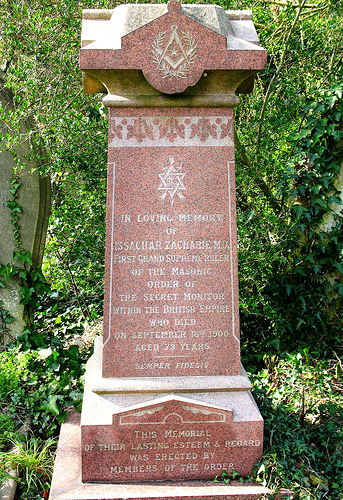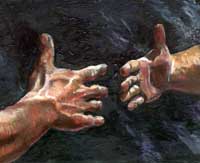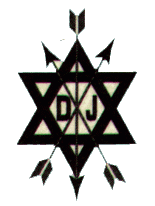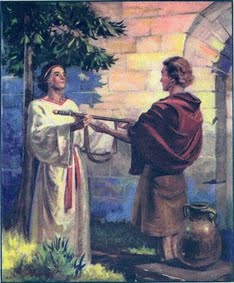THE ORDER OF THE SECRET MONITOR
THE BROTHERHOOD OF DAVID AND JONATHAN
A Unique Order which Possesses a Universal Appeal for Brethren of all Religious Persuasions
The Order of the Secret Monitor, or Brotherhood of David and Jonathan is governed by the Grand Conclave from its headquarters at 86 St. James’s Street, London. The Order, which embodies a series of three ceremonies, constitutes one of the most significant international fraternities to be found within Freemasonry. Its teachings are embraced by Brethren from all the major religions of the world.
It is generally acknowledged by scholars that the fraternity of David and Jonathan, or the Order of Brotherly Love, originated in Holland where a secret masonic society of that name was functioning before 1778; but it was to New York, whence it was carried by immigrants, where it appears to have had its initial development. Little or no records were kept at the outset as it was conferred as a ‘side degree’ without fee by one mason upon another thus spreading throughout the Republic in a variable and simplified form often with differing titles – the ‘Trading Degree’ being one common alternative.
Numerous references were made to this degree during the nineteenth century with the Order of Brotherly Love being incorporated in Scotland as the 16th degree of the multifarious system of the Early Grand Rite, while a version was also printed in the Ritual of Freemasonry, 1835.

The Order of the Secret Monitor, or Brotherhood of David and Jonathan is governed by the Grand Conclave from its headquarters at 86 St. James’s Street, London. The Order, which embodies a series of three ceremonies, constitutes one of the most significant international fraternities to be found within Freemasonry. Its teachings are embraced by Brethren from all the major religions of the world.
It is generally acknowledged by scholars that the fraternity of David and Jonathan, or the Order of Brotherly Love, originated in Holland where a secret masonic society of that name was functioning before 1778; but it was to New York, whence it was carried by immigrants, where it appears to have had its initial development. Little or no records were kept at the outset as it was conferred as a ‘side degree’ without fee by one mason upon another thus spreading throughout the Republic in a variable and simplified form often with differing titles – the ‘Trading Degree’ being one common alternative.
Numerous references were made to this degree during the nineteenth century with the Order of Brotherly Love being incorporated in Scotland as the 16th degree of the multifarious system of the Early Grand Rite, while a version was also printed in the Ritual of Freemasonry, 1835.
However, the present-day Order emerged through the efforts of a Dr. Issacher Zacherie, an Englishman who served as a Surgeon on the Federal side during the American Civil War. Following the end of hostilities he settled in California and developed his masonic career, gaining this new degree.Around 1875 he returned to England, establishing a practice in Mayfair, London, and on taking up his masonic duties he met several other prominent Brethren who were also in possession of the degree.
They subsequently resolved to form a Conclave with the consequence that a Grand Council was formed under the Doctor’s leadership in July 1887. After some deliberation, it was adjudged that the existing ritual was inadequate and should be rewritten and by the following year, ceremonies for a second and third degree had been skilfully prepared and issued through the independent secretariat of the Order.
The degree soon gained popularity which success generated problems with the newly formed Grand Council of the Allied Masonic Degrees which had been established to unify all unattached degrees. Having acquired a similar degree of that name from their American counterparts they subsequently proscribed the new ‘Grand Council’. Nevertheless, the Order of the Secret Monitor prospered during an uncomfortable period of 37 years, with the degree – while starkly different – being conferred by two grand bodies.
The matter was finally resolved in 1931 when C. W. Napier-Clavering was in the advantageous position of being Grand Supreme Ruler of the Order of the Secret Monitor as well as Grand Master of Allied Masonry, an opportunity he used to implement an agreement transferring all rights over the degrees to the Grand Council of the Secret Monitor.
The basis of this distinctive Order is framed around the scriptural readings taken from 1 Samuel, Chapter 20. Nearly 300 years after the Exodus popular demand amongst its peoples dictated that Israel should have its own king and Samuel, the reigning Judge, anointed Saul, of the Tribe of Benjamin.
At first he was a wise and successful ruler who consolidated the kingdom but eventually he fell victim to the corruption of absolute power developing into an unjust and feared tyrant which caused great discontent. Accordingly, Samuel was commanded by God to appoint a new leader and he secretly anointed David son of Jesse, a shepherd boy, the Psalmist of the King, who was to prove himself to be an accomplished warrior.
Saul became incensed by the success of his servant, whom he saw as a threat to his throne, and determined that David should die. The king’s son Jonathan, who was well aware of the treacherous designs of his father, apprised David of the impending danger which enabled him to escape to a refuge in the wilderness.
Such selfless acts of Jonathan described in the Old Testament demonstrate an unparalleled strength of loyalty and Brotherly Love, that of placing the interests of another above those of oneself; the intrinsic attribute that should characterise every virtuous Freemason.
THE DEGREES OF THE ORDER
1º - Member of the Order
It is obligatory that all Brethren seeking admission into the Order must minimally hold the rank of Master Mason. As in all masonic ceremonies, induction into the Order demands that the candidate be obligated prior to being entrusted with the secrets of the degree. A moving account of the unfaltering friendship that existed between David and Jonathan is then related and the newly inducted brother is exhorted to recognise his duty to safeguard - to monitor - the welfare of a Brother should he be about to do anything that may prove to be injurious to himself. Reference is also made to the particular significance of the bow and arrow after which he is duly invested.
2º - Prince of the Order
Admission to an Assembly of Princes is only open to members of the Order who, upon entering, are required to take an obligation following scriptural readings that depict the savage and unpredictable demeanour of King Saul. An extensive narrative then describes how David and his warriors, on being pursued by Saul, succeed in establishing an unassailable sanctuary in the mountainous region to the West of Hebron and describes the ingenious method adopted to ensure that their mountain stronghold should not be penetrated. It also refers to the undying oath of friendship sworn between David and Jonathan when unknown to them they were to meet for the last time.
3º - Supreme Ruler
The ceremony of elevation to this final grade is quite unique for while it incorporates Installation into the chair of a Conclave it also constitutes the Third degree of the Order and a certificate is issued to that effect; the only body in Freemasonry to observe such a custom.
The biblical references allude to David’s accession to the throne, the covenant he made with his subjects and his anointment and recognition as King over all Israel. Advancement to this position can only be conferred upon a Prince of the Order who must have served in one of the two senior offices within a Conclave.
This superior degree also embodies a special Ceremony of Commissioning which is conferred by the appropriate officer when the incumbent is anointed, dubbed, invested with a purple robe of kingship, and duly acknowledged as a Supreme Ruler within the Order. Following this the Brethren are united in an enactment of the feast ordained by King David when the Ark of the Covenant was placed within the Tabernacle.
After his Induction, a Brother is invested with the Member’s Jewel comprising two gilt equilateral triangles interlaced with three arrows, and charged with the letters D and J - the emblem of the Order. It is suspended from a ribbon with three equal stripes of Violet –Yellow – Violet. The sash worn by 1st degree officers is of Crimson with two gilt interlaced triangles on the frog and a gold fringe.
The jewel of a Prince of the Order is identical to that of the previous degree but is suspended from a ribbon with three equal stripes of Yellow – Violet –Yellow. The 2nd degree officer’s sash has two outer Yellow stripes and two inner Violet stripes with a central Crimson stripe bearing a gilt motif on the frog. It also has a gilt fringe.
A Supreme Ruler wears the Jewel of the Order suspended from a collarette in the colors of the 2nd degree, together with a similar sash embroidered with the letters S.R. in silver and the name of the Conclave beneath. He also wears a violet robe with gold facings. Brethren who advance to the rank of Provincial Officer continue to wear the Jewel of the Order suspended from a collarette of blue together with a similar sash bearing the name of the Province embroidered above the emblem of the order and the initials of the office held.
The regalia of a Grand Officer comprises the Jewel of the Order framed in a pointed oval worn from a collarette of Yellow bordered with Crimson, while his sash is of Crimson bordered and embroidered in gold with the Emblem, surmounted by the initials of the wearer’s rank and a Celestial Crown.
The Order of David and Jonathan is devoted to the practical elucidation of the masonic virtue of Brotherly Love and is the only Order in Freemasonry where each Conclave is required to appoint four Visiting Deacons who are deputed to maintain contact between meetings with every Brother allocated to their ‘care’ either by letter, visitation or telephone and to render a frequent report concerning their charge’s welfare. The use of first names, with the appropriate honorific, is actively encouraged outside the Conclave which further promotes the strengthening of their fraternal bond.
This all-embracing approach to brotherhood has doubtless contributed to the Order’s international appeal and success, for in addition to the United Kingdom the Grand Conclave administers over seventy Conclaves in the sub-continent of India, as well as Provinces in the Far East, South Africa, Spain and the Caribbean, while it continues in amity with its five daughter Grand Conclaves situated in Australia, New Zealand and Canada.
(Courtesy : Keith Jackson, in Freemasonry Today)
David And Jonathon
Jonathan - A Prince of Israel
Jonathan, prince and son of Saul, was the heir apparent to the throne of Israel. He was destined to rule after the death of his father. Jonathan was well aware of this and the promises God would have made to his father had Saul been faithful.
Jonathan was a young man of courage, strength, and determination who looked to and relied on God. He was a mighty soldier in his own right—highly respected and trusted by the men he led.
These character traits were clearly evidenced when Jonathan fought against a garrison of Philistine soldiers with only his armor bearer by his side, leading to a great victory for Israel.

David -A Keeper of the sheep
On the other hand, David, the youngest son of Jesse, was a ruddy, bright-eyed shepherd boy. On two occasions, he rescued his father’s sheep from a predator—a lion and a bear—literally grabbing hold of them and slaying them. These feats and others caused him to be known as one “who is cunning in playing [the harp], and a mighty valiant man, and a man of war, and prudent in matters, and a comely person”. In fact, it was David’s ability to play the harp that first won him favour with Saul. The soothing music that David skilfully played refreshed and calmed Saul’s troubled spirit. This moved the king to bestow upon him the great honour of being his armour bearer. Eventually, through marriage to the king’s daughter, Michal, David even became a prince in Israel, and brother-in-law to Jonathan. But as David grew in stature and respect among the army and the people of Israel, Saul’s love and favour turned into bitterness, resentment and hate. Saul became determined to murder David, since he knew that David would replace him on the throne. This also meant that Jonathan would never be king.





